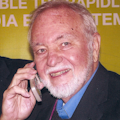Fourth generation (4G) wireless technology is so yesterday. Everyone with a smartphone is taking for granted that LTE will deliver fast downloads and no dropped calls. This attitude exists despite the yet-to-be-completed rollout of LTE by the major carriers. On top of that, work on the next generation (5G) systems has already begun. Something to look forward to.
What is 5G? The industry is still making it up as it goes along but most of the work seems to be focused on small cells and millimeter waves. The small cell movement is going to work with LTE and that approach may extend into 5G. As for millimeter (mm) waves they are generally said to occupy the 30 to 300 GHz range but some less than 30 GHz systems are also considered mm wave. Millimeter waves despite their high frequency are already widely used. Think of WiGig 802.11ad 60 GHz wireless for video and 60, 70 and 80 mm backhaul systems. There is also car radar at 77 and 79 GHz and all sorts of military and satellite systems that use that range.
There are several roadblocks to the use of mm waves for cell phones. First is the inherent natural physics of waves at these frequencies is short range. Remember, for a given power level, antenna gains and receiver sensitivity, the range of a wireless signal is proportional to wavelength. That translates to a shorter distance the higher the frequency. The secret to overcoming this limitation is more power by way of high gain highly directional beamforming and self-orienting antennas. Antenna sizes at these frequencies are tiny meaning they can be part of large directional phased arrays that can be steered. A half wavelength dipole at 30 GHz for example is only about a 5 mm so even large arrays are tiny. Higher frequencies would yield even smaller antennas. How we can fit steered beamforming arrays in a handset is yet to be determined but we cram multiple antennas into cell phones now, so why not?
Another roadblock is regulations. The FCC would have to plan and assign or even reassign spectrum for cellular operation. That could take a while. But there is lots of room in those elevated bands. Download speeds could easily top 1 Gb/s. Furthermore, the standards organizations will have to get involved. An European 5G public-private partnership (PPP) project is forming to work on 5G.
Research is under way for 5G. Dr. Ted Rappaport at NYU WIRELESS has done some great work with small cells in the mm bands in NYC proving that mm wave cellular is possible. Intel and others are also doing work in this area so 5G is underway. Don’t hold your breath as it will be many years before we see real systems.
In the meantime, we can turn our attention to LTE-Advance. LTE-A is the most recent version of LTE from the Third Generation Partnership Project (3GPP) the group that develops cellular standards. LTE-A is actually the real 4G. It builds on the solid LTE base and adds some features that further boost data rates with given spectrum constraints and makes other incremental improvements. The key features are carrier aggregation and higher order MIMO. Carrier aggregation lets the system put together multiple 20 MHz bands, contiguous or not, to form up to a composite 100 MHz bandwidth capable of supporting up to 3 Gb/s downstream data rates. MIMO further helps with a MIMO configuration to 8x8. How you implement that is still a vision. A 4x2 may be the most practical with four antennas in the basestation and two in the handset which is already crowded with multiple cellular antennas, Wi-Fi, Bluetooth and GPS antennas.
If you really want to do a deep dive into LTE-A there is a new book that will help you do that. I discovered it while updating my college textbook and it certainly gives in-depth coverage. It is entitled LTE-Advanced, A practical Systems Approach to Understanding the 3GPP LTE Releases 10 and 11 Radio Access Technologies by Sassan Ahmadi. The book delves into the LTE-A standards specifics and covers new material on VoLTE, small cell HetNets, Wi-Fi offload, carrier aggregation, and even LTE broadcast. If you want a look at what is coming down the road in LTE systems, this book is a good place to start. It is available from Academic Press/Elsevier. www.elsevier.com
We won’t see 5G for a while and even LTE-A is a few years off but both will help us all get the high speed and connectivity we have all become addicted to.
About the Author

Lou Frenzel Blog
Communications Technology
Click here to find more of Lou's articles on Electronic Design.